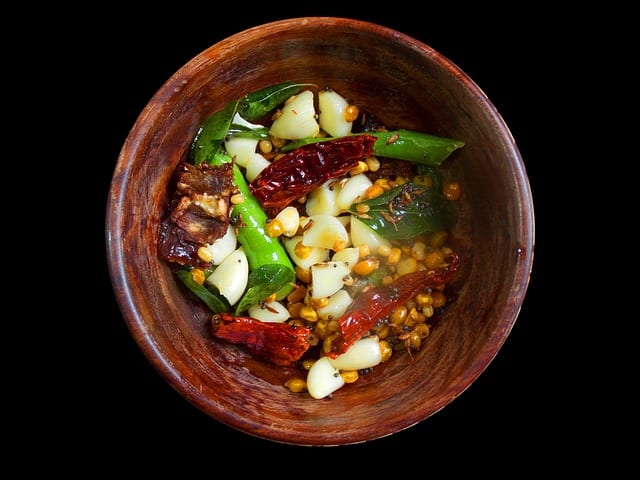In the context of Ayurveda, a traditional system of medicine in India, spices are categorized into three categories – Sattvic, Rajasic, and Tamasic – based on their qualities and effects on the body and mind.
Rajasic spices are those that are believed to stimulate the mind and increase activity and restlessness. These spices are typically pungent, bitter, or sour in taste and can be heating or warming in nature.
Examples of rajasic spices include:
- Black pepper
- Ginger
- Mustard seeds
- Garlic
- Onion
- Cayenne pepper
- Cumin
- Cloves
- Fenugreek
- Turmeric
These spices are believed to be beneficial in small amounts for people who need more energy and stimulation in their lives, but excessive consumption can lead to imbalances in the body and mind. It is important to use spices in moderation and in accordance with one’s individual constitution and needs.
The Role of Rajasic Spices in Ayurvedic Cooking
Ayurveda, the ancient system of medicine in India, places great emphasis on food as medicine. Ayurvedic cooking uses a variety of herbs and spices, including the category of rajasic spices, to create nourishing and healing meals. These potent spices are known for their stimulating and energizing properties and can be used to create flavorful and balanced dishes.
Rajasic spices are typically pungent, bitter, or sour in taste and can be heating or warming in nature. They are believed to have a stimulating effect on the mind and body and are used to increase activity and restlessness.
Here are some of the common rajasic spices used in Ayurvedic cooking:
- Black Pepper: Black pepper is a common spice used in Ayurvedic cooking to aid digestion and stimulate metabolism. It is believed to have a warming effect on the body and can be used in a variety of dishes, from soups and stews to marinades and dressings.
- Ginger: Ginger is a potent anti-inflammatory spice that is commonly used in Ayurvedic cooking. It can help to improve digestion, reduce inflammation, and boost immunity. Ginger can be used in a variety of dishes, from soups and stir-fries to teas and tonics.
- Mustard Seeds: Mustard seeds are commonly used in Ayurvedic cooking to aid digestion and reduce congestion. They have a pungent flavor and can be used in a variety of dishes, including curries and pickles.
- Garlic: Garlic is a potent antioxidant and anti-inflammatory spice that is commonly used in Ayurvedic cooking. It can help to improve digestion, reduce inflammation, and boost immunity. Garlic can be used in a variety of dishes, from soups and stews to stir-fries and marinades.
- Onion: In Ayurvedic cooking, onions are often used as a base for curries, soups, and stews. They can also be sautéed with other vegetables, such as carrots, bell peppers, and mushrooms, to create flavorful and nutritious dishes. Onions can also be used to add flavor to lentil dishes, rice dishes, and stir-fries.
- Cayenne Pepper: Cayenne pepper is a potent spice that is commonly used in Ayurvedic cooking to aid digestion and boost metabolism. It has a warming effect on the body and can be used in a variety of dishes, from soups and stews to marinades and dressings.
- Cumin: Cumin is a common spice used in Ayurvedic cooking due to its digestive properties. It is believed to stimulate the digestive fire, or Agni, and can be used in a variety of dishes, such as soups, stews, and rice dishes, to aid digestion and improve nutrient absorption.
- Cloves: Cloves are a warming spice commonly used in Ayurvedic cooking due to their stimulating and energizing properties. They are believed to aid digestion, reduce inflammation, and help to balance the doshas, or energetic forces, in the body. Cloves can be used in a variety of dishes, such as curries, rice dishes, and teas, to add flavor and promote overall health and well-being.
- Fenugreek: Fenugreek is a versatile spice used in Ayurvedic cooking for its medicinal properties. It is believed to stimulate digestion, balance blood sugar levels, and promote milk production in breastfeeding women. Fenugreek can be used in a variety of dishes, such as curries, soups, and stews, to add a slightly bitter, nutty flavor and provide numerous health benefits.
- Turmeric: Turmeric is a staple spice in Ayurvedic cooking due to its anti-inflammatory and antioxidant properties. It is believed to aid digestion, support liver health, and boost immunity. Turmeric can be used in a variety of dishes, such as curries, soups, and stews, and can also be added to milk or tea for a soothing and nutritious beverage.
The role of rajasic spices in Ayurvedic cooking is to create balanced and flavorful meals that nourish and heal the body. These spices are used in moderation and according to individual constitution and needs. They can be used to create a variety of dishes, from soups and stews to teas and tonics, and can be combined with other herbs and spices to create delicious and healing meals.
Final thoughts
The use of rajasic spices in Ayurvedic cooking is an important aspect of creating nourishing and healing meals. These potent spices can help to improve digestion, reduce inflammation, boost immunity, and increase energy levels.
By incorporating these spices into your cooking, you can create balanced and flavorful meals that support your overall health and well-being.

